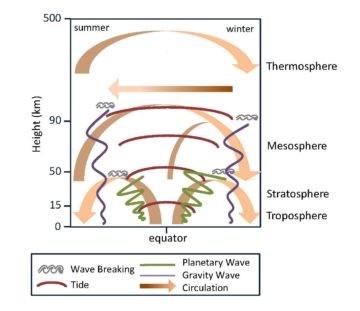Whole Atmosphere Climate Change
Impacts of climate change in the lower and middle atmsophere on the upper atmosphere
- Start date
- 1 December, 2018
- End date
- 28 February, 2025
The near-Earth space environment is host to an increasing amount of advanced, satellite-based technology, used for both commercial and
scientific purposes. To safeguard this technology and ensure that we can continue exploiting this environment safely and effectively, reliable predictions of future upper atmosphere conditions, especially the density, are essential. A clear understanding of the causes of long-term (multi-decadal to centennial) changes is therefore needed. This project will quantify the role of climatic change in the lower and middle atmosphere (0-90 km altitude) in causing long-term changes in the state of the upper atmosphere (90-500 km altitude).
The lower and middle atmosphere affect the upper atmosphere atmospheric waves that propagate upward. As the waves travel up, their amplitude increases due to the exponential decrease in atmospheric density with height. The amplitudes of the waves eventually become so large that they become unstable and break, similar to waves on a beach. When they break, the waves transfer energy and momentum to the surrounding atmosphere, which drives large-scale, global circulations and causes mixing (see figure). Both the characteristics of the waves, and the state of the surrounding atmosphere, determine how far these waves can propagate (in altitude as well as horizontally) and when they break.

There is evidence that, as a result of man-made climate change in the lower and middle atmosphere, both wave generation processes and wave propagation conditions have changed over the past 4-5 decades, with further changes expected in the future. This has already caused changes in large-scale circulation patterns in the troposphere and stratosphere, and it is likely to affect the climate of the upper atmosphere as well.
This project will quantify the importance of man-made climate change in the troposphere, stratosphere, and mesosphere (lower and middle atmosphere) in causing long-term changes in the thermosphere and ionosphere (upper atmosphere), both in the past (1950s-2000s) and projected into the future (2050s) according to established emission scenarios. Computer simulations with a state-of-the-art, global, 3-dimensional climate model, extending from the surface up to ~500 km altitude, will be used to do this. Results from these simulations will be compared to observed long-term changes in the upper atmosphere (e.g., in temperature, density) and to contributions made by other known factors.